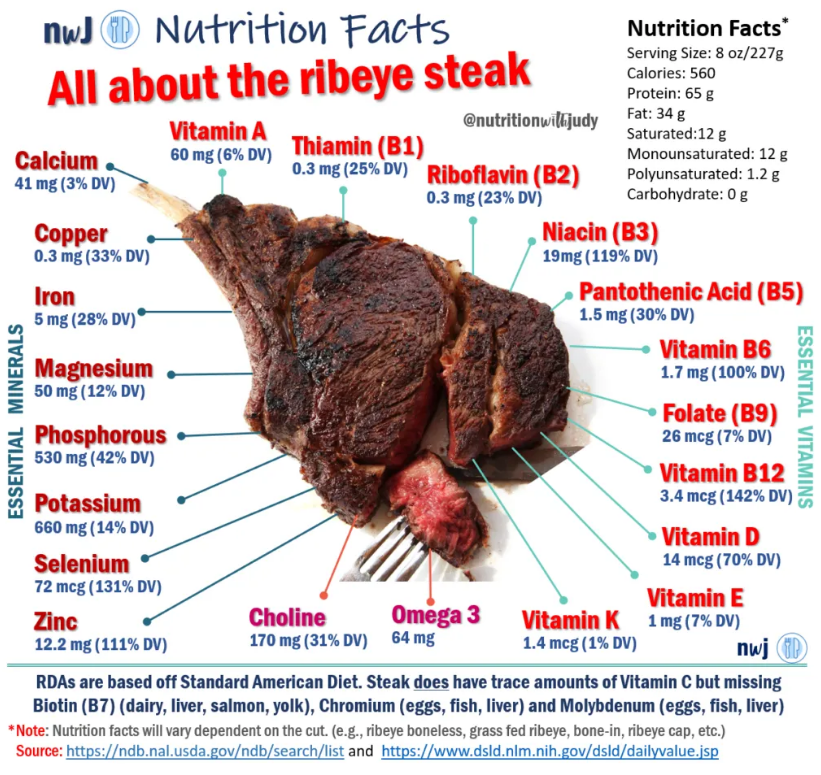Meat has been part of the human diet for around 2.6 million years. It is a complete protein consisting of tryptophan, methionine, histidine, phenylalanine, isoleucine, valine, lysine, threonine, leucine, which are essential amino acids our bodies cannot make, so must be ingested.
Red and white meat are a phenomenal basis for health and to underpin fitness, helping to maintain muscle mass, strong bones.
Meat is a unique source of vitamin B12, there are four additional nutrients that are only found in meat (fish and eggs). They include:
Creatine: Creatine is an important nutrient in muscle and brain that helps to supply energy.
Carnosine: Carnosine is considered a potent antioxidant. Some theories propose it could help treat neurocognitive disorders such as Alzheimer’s Disease. Best sources are lean beef, yellowfin tuna and eel.
Vitamin D3: The body uses D3 found in meat. Very few foods naturally contain D3. They include beef liver and pork liver. Fatty fish, egg yolks and beef and pork cuts, also contain D3 but at lower levels than in the liver.
DHA: DHA or Docosahexaenoic acid is the most abundant Omega-3 fatty acid in the brain and it is critical for normal brain development. DHA and EPA, both long chain omega-3 fatty acids, are recommended as a source of fat for children to support cognitive function and brain development. It is also very important for women at a childbearing age, because a woman’s Omega-3 status could effect the brain of the offspring. Fatty fish are the best source of DHA. Beef also contains DHA. (https://www.meatpoultrynutrition.org/content/benefits-meat-and-poultry-diet)
No human randomised controlled trials show that meat causes harm. Epidemiology studies (food questionaires) that show an "association" of detrimental effects of meat, never meet the scientifc standard required to move to the next more detailed clincal trial. During the decades when red meat was consumed more there was less cancer and other non-communicable diseases. The reported risk of 50 grams of processed meat eaten per day, leading to an 18% risk of colorectal cancer, is a statistical slight of hand, using a measurement called "relative risk". With relative risk you can say 50% of people support Rhino hunting. On closer inspection if the number of people sampled was just 2, the problem of relative risk is highlighted.
The 18% increase (if you accept the food questionaires and statistical method used) relates to a change from 43 in 100,000 to 51 in 100,000, not convincing. Proponents of meat further argue that if a cheese burger and fries, or spagetti bolognese are being judged, the problem is not the meat, but scrutiny should be focused on the carbohydrates within the burger bun, fries and pasta, as well as the vegatable oils used. There are plenty of first world ancestral meat eaters such as the Masai Warriors, who have a predominantly meat based diet and have been tested to show no ill effects of a meat based diet.
The longest lived population are located in Hong Kong and they eat the most meat per capita. (https://www.carnivoreisvegan.com/hong-kong-long-life-eat-meat/). Gaps can be filled in why there is a push to reduce meat and promote both alternative processed analogues and inferior food like products.
By British Producers and Consumers trading direct, this most nutritious of foods can be locally sourced and protected.
91% of British households enjoy red meatBritish livestock is produced to some of the highest animal welfare standards in the world.British beef and lamb is among the most efficient and sustainable in the world due to our extensive, grass-basedsystems. Emissions from beef production in the UK are about half the global average, according to the Government’s Committee on Climate Change.65% of UK farmland is best suited for growing grass for animals to eat.87% of UK beef is produced using predominantly foragebased diets , with only a very small amount of soya in rearing diets. This means UK beef production is not a driver of deforestation in other parts of the world.The introduction of grass and clover leys and livestock into arable crop rotations is beneficial to soil health and fertility. This regenerative approach helps build soil fertility.Emissions from UK livestock are estimated to be around 5% of the country’s total GHG emissions, significantly lower than the estimated EUwide figure for livestock of around 9.1% of all emissions. This is in part due to the UK’s efficient production systems.Actively managed pastures that are grazed by livestock are a good carbon sink, capturing CO2 in the vegetation and storing carbon in the soil which could otherwise be released into the atmosphere, as are hedgerows that separate fields. If this land was put to other uses, and the soil was disturbed, there is a risk that much of that carbon stored within it would be lost to the atmosphere as carbon dioxide.

 01
01
Lorem ipsum dolor sit amet, consectetur adipisicing elit, sed do eiusmod tempor incididunt ut.
 02
02
Lorem ipsum dolor sit amet, consectetur adipisicing elit, sed do eiusmod tempor incididunt ut.
 03
03
Lorem ipsum dolor sit amet, consectetur adipisicing elit, sed do eiusmod tempor incididunt ut.
 04
04
Lorem ipsum dolor sit amet, consectetur adipisicing elit, sed do eiusmod tempor incididunt ut.